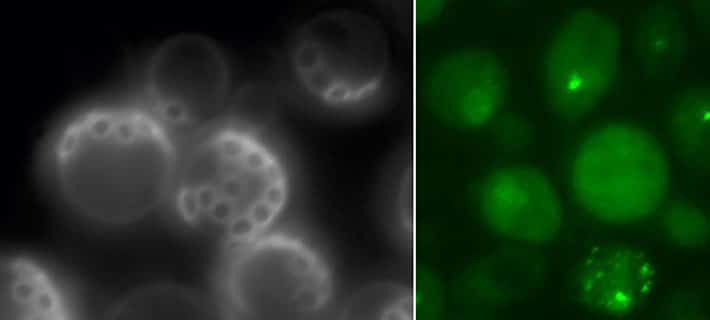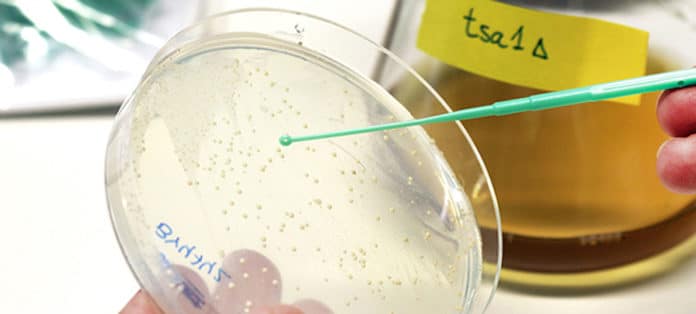Oxidants, i.e., reactive oxygen species, can harm cells in all organisms and are linked to aging. A study from the Chalmers University of Technology, Sweden, has now indicated that low levels of the oxidant hydrogen peroxide can stimulate an enzyme that slows down yeast cells’ aging.
Despite neutralizing oxidants, antioxidants may otherwise react with essential molecules in the body and destroy their biological functions. Large amounts of oxidants can cause severe damage to DNA, especially cell membranes and proteins. Our cells have thus developed powerful defense mechanisms to get rid of these oxidants.
Previously, oxidants were considered as only harmful, but now, scientists have begun to understand oxidants’ positive functions. In a new study, scientists show that the well-known oxidant hydrogen peroxide can slow down yeast cells’ aging.
Scientists studied the enzyme Tsa1, which is part of a group of antioxidants called peroxiredoxins. Peroxiredoxins are H2O2 scavenging enzymes that also carry out H2O2 signaling and chaperone functions. In yeast, the major cytosolic Peroxiredoxin, Tsa1, is required to promote resistance to H2O2 and extend lifespan upon caloric restriction.

Mikael Molin, who leads the research group at Chalmers‘ Department of Biology and Biological Engineering, said, “Previous studies of these enzymes have shown that they participate in yeast cells’ defenses against harmful oxidants. But the peroxiredoxins also help extend the life span of cells when they are subjected to calorie restriction. The mechanisms behind these functions have not yet been fully understood.”
Several research groups, including Mikael Molin’s, have also shown that stimulation of peroxiredoxin activity particularly slows down the aging of cells in organisms such as yeast, flies, and worms when they receive fewer calories than normal through their food.
Cecilia Picazo, a postdoctoral researcher at the Division of Systems and Synthetic Biology at Chalmers, said, “Now we have found a new function of Tsa1. Previously, we thought that this enzyme neutralizes reactive oxygen species. But now we have shown that Tsa1 requires a certain amount of hydrogen peroxide to be triggered to participate in the process of slowing down the aging of yeast cells.”
Shockingly, the investigation shows that Tsa1 doesn’t influence the levels of buiperoxide in aged yeast cells. In real, Tsa1 uses limited amounts of hydrogen peroxide to reduce a central signaling pathway activity when cells are getting fewer calories. This ultimately leads to a slowdown in cell division and processes connected to the development of the cells’ building blocks. The cells’ defeces against stress are also stimulated- which makes them age all the more slowly.
Mikael Molin said, “Signal pathways which are affected by calorie intake may play a central role in aging by sensing the status of many cellular processes and controlling them. By studying this, we hope to understand the molecular causes behind why the occurrence of many common diseases such as cancer, Alzheimer’s disease, and diabetes shows a sharp increase with age.”
Scientists now have come closer to understanding the mechanisms behind how oxidants can slow down the aging process. This could lead to more studies, such as looking for peroxiredoxin-stimulating drugs or testing whether age-related diseases can be slowed by other drugs that enhance the positive effects of oxidants in the body.
The Chalmers analysts have indicated a mechanism for how the peroxiredoxin enzyme Tsa1 legitimately controls a central signaling pathway. It hinders aging by oxidizing an amino acid in another enzyme, protein kinase A, which is significant for metabolic regulation. The oxidation decreases the activity of protein kinase A by destabilizing a portion of the enzyme that binds to different atoms. Consequently, nutrient signaling using protein kinase A is reduced, which downregulates the division of cells and stimulates their defense against stress.
Other studies have also shown that low levels of reactive oxygen species can be linked to several positive health effects. These oxidants are formed in the mitochondria, can be observed in many organisms, from yeast to mice. In mice, tumor growth is slowed by mitohormesis. Simultaneously, in roundworms, it has been possible to link both peroxiredoxins and mitohormesis to the ability of the type 2 diabetes drug metformin to slow cellular aging.
Journal Reference:
- Friederike Roger et al. Peroxiredoxin promotes longevity and H2O2-resistance in yeast through redox-modulation of protein kinase A. DOI: 10.7554/eLife.60346
